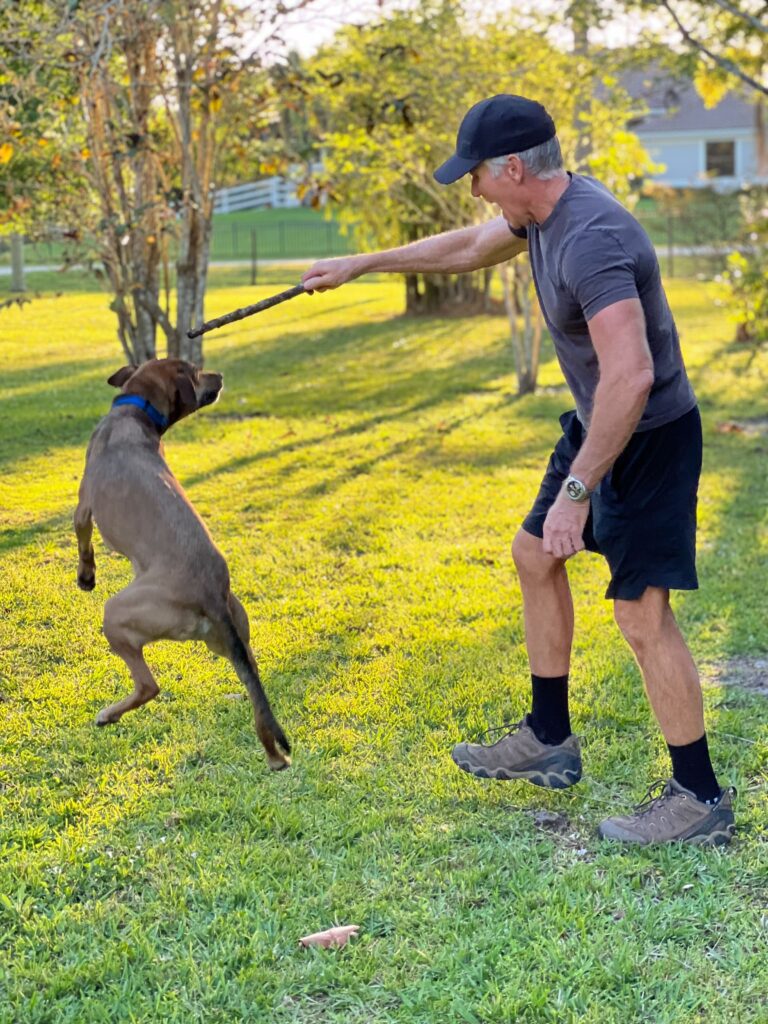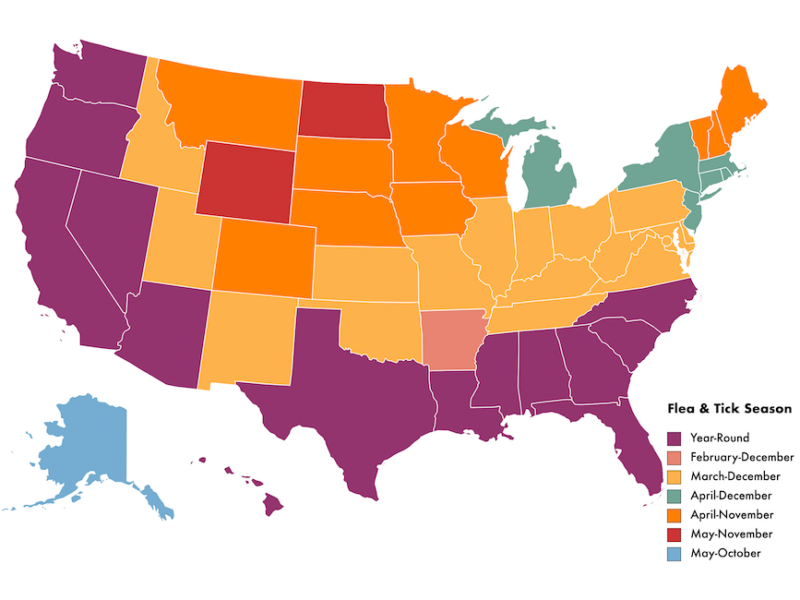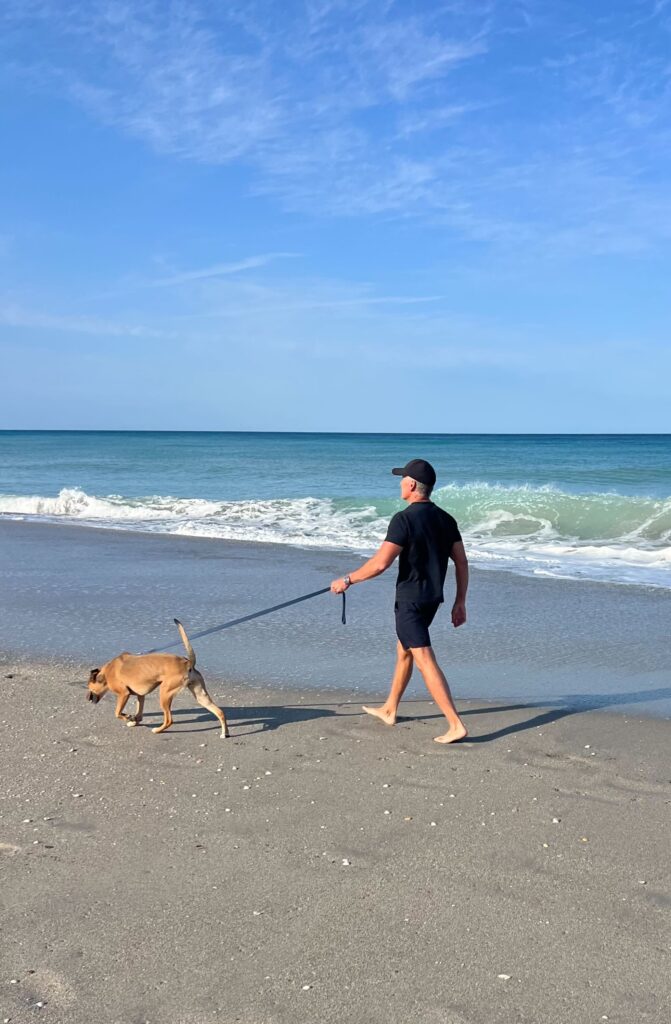Table of Contents
Here it comes… the dreaded peak flea and tick season.
For us pet owners, while we love those sunny beach trips and walking in the park full of blooming flowers, summer and springtime also mean parasites lurking everywhere.
According to ASPCA, fleas and ticks thrive in moist, humid, and shady areas. Wood piles and tall grass are also among their favorite hangout spots. That means dog parks, campsites, and even your backyard!
As we know, preventing them from clinging to our pets' coats is necessary, not only because they are nuisances but also because they are vectors of different diseases.
Good thing, there are a couple of ways we can protect our pets from these unwanted pests. I should know because I live in a tropical climate and am used to seeing fleas and ticks every now and then.
In this article, I'll share 4 of my tried-and-tested tips and tricks for navigating the peak flea and tick season, plus everything you need to know about it.
Let's get started!

When is the peak flea and tick season?
First things first… when is the peak flea and tick season?
Fleas and ticks mostly survive in mild to moderate temperatures. And for most states, that means springtime and summertime.
But if you live in the warmer states, you may want to be on guard all year round. In fact, that's the most sensible thing to do—a year-long protection against ticks and fleas wherever you live.
Some evidence also points to fall as possibly the worst season for pet owners.
“Though most people think that fleas are only an issue in the spring and summer, don't ignore the fall,” said Dr. Adam Denish of Rhawnhurst Animal Hospital in Pennsylvania to PetMD.
“In our practices, we tend to see more fleas from September to October as the cool weather leads the fleas indoors to your warm pets and houses. Fleas will die outside in the cold, but once inside, they can spend the winter,” he added.
Yes, these tiny, little pests can be home invaders, too.
And remember, flea and tick-borne diseases don't only affect pets. Once they enter your home, they can also bite you and your family members, which can cause a whole other level of health problems.
What is the flea and tick season in your state?
The flea and tick season might depend on your geographical location. Some have it for a couple of months, and some all year round.
Check out the American Kennel Club's visual map below on the peak flea and tick season in the United States.

As you can see, all the warmer states on the West and South Coast can experience flea and tick surges year-long.
So, if you and your pet live in those areas, you better gear up against the enemies!
Dangers of fleas and ticks to dogs in this season
Flea and ticks are both hematophagous parasites—they live off of the blood of their host organism.
One of the common irritations your pet may suffer when bitten by fleas is flea allergy dermatitis, which is caused by their saliva. Signs of flea allergy dermatitis are itching red and scabby skin, and hair loss.
Other problems that flea and tick bites may bring are:
- Flea bite anemia
- Lyme disease
- Ehrlichiosis
- Anaplasmosis
- Rocky Mountain Spotted Fever
- Babesiosis
Some of the diseases mentioned above can also be contracted by humans when bitten by an infected parasite.
Ehrlichiosis, for example, is caused by the bacteria Ehrlichia chaffeensis, E. ewingii, or E. muris eauclairensis. They can spread to animals and humans through the bite of an infected tick.
Some signs and symptoms of Ehrlichiosis in humans are fever, chills, headache, muscle ache, and stomach ache.
In dogs, it can manifest as swollen lymph nodes, weight loss, fever, bleeding, and respiratory distress, among others.
When not treated immediately, Ehrlichiosis can be life-threatening for both animals and humans.

Take extra care this season!
It goes without saying that taking extra care is important during the peak flea and tick season in your area.
Not only will it ensure your dog's overall health and well-being, but you'll also protect your home and family members from possible tick and flea infestation.
Fleas and ticks have been among the bane of our pets' existence for the longest time. Fortunately, pet owners have also perfected ways to protect their pets from flea and tick infestation.
I've been a pet owner for about 5 years and have always lived in a warm climate. I'd say I've already mastered my way into preparing my dogs for battle, so to speak.
Here are some tips I've learned from experts and other pet owners throughout the years.

4 Ways to Prepare Your Dog for the Peak Flea and Tick Season
1. Using Flea and Tick Treatments
Flea treatments are an absolute must when protecting your dogs against unwanted parasites.
One brand that many veterinarians prescribe is BRAVECTO® (fluralaner) Chews.
It's the only extended-duration flea and tick medication that lasts longer than other treatments. Most options in the market require redosing every month, but the BRAVECTO® (fluralaner) Chews can protect pets for up to 12 weeks.
Because BRAVECTO® lasts nearly three times longer than the other monthly chews, you'll only have to buy and give this to your dog less frequently. For full product and safety information, visit us.bravecto.com
2. Regular Grooming or Brushing
Grooming or even just brushing your dog's fur on a regular basis will allow you to inspect their coat for any signs of fleas or ticks.
Inspect every nook and cranny of your dog's body—armpits, neck, between the toes, in and around the ears, near the eyes, groin, and tail.
Do this, especially when your dog has just returned from potty breaks or an outside walk.
3. Always Keep Your Environment Clean
Remember when I said fleas and ticks love moist, shaded areas? That includes your backyard. If you have one, ensure your lawn is always mowed, the grass trimmed, and the weeds removed.
Make sure that your outdoor garbage is also always sealed to prevent any wild animals that may be carriers of fleas and ticks from entering your property.
Of course, there's still more cleaning to do inside the house. Wash your bedding and carpets regularly, especially those that your dog frequents.
You should also wash their toys, blankets, clothes, and other cloth materials they use that parasites can cling to. Because, you know, you can never be too sure.
4. Consult with Your Veterinarian
The last and perhaps the best thing you can do when gearing up for peak flea and tick season is to consult your vet.
They will provide all the necessary information you should know and recommend products you can use to help protect your pet from fleas, ticks, and other unwanted parasites.
Building a good relationship with your pet's vet will also guarantee they'll answer your questions even via text message (trust me, I know!)

It's important to understand, though, that whatever measures we take, fleas and ticks can be inevitable.
After all, several factors contribute to their infestation: regional changes in tick distributions, our inability to control the hosts (a.k.a. our pets and other animals), and other factors well out of our control.
Following the tips and tricks above does not guarantee that fleas or ticks will never bite your dog. But they should be enough to protect our pets (and our family) from the dangers that the bites of these parasites may bring.
How about you? How do you navigate this irritating problem?
Disclaimer: This blog is sponsored by Merck Animal Health. However, the article remains truthful and reflects the author's genuine experiences. Readers are advised to conduct their own research and seek professional advice before acting on any information provided. Merck Animal Health values transparency and honesty in all collaborations.
*BRAVECTO (fluralaner) Chews for Dogs kills fleas, prevents flea infestations, and kills ticks (black-legged tick, American dog tick, brown dog tick, and Asian longhorned tick) for 12 weeks. BRAVECTO Chews also kills lone star ticks for 8 weeks.
BRAVECTO (fluralaner) Chews for Dogs: The most commonly reported adverse reactions include vomiting, lethargy, diarrhea, anorexia and pruritus. In some cases, adverse events have been reported following use in breeding females. BRAVECTO Chews has not been shown to be effective for 12-weeks' duration in puppies less than 6 months of age. BRAVECTO Chews is not effective against lone star ticks beyond 8 weeks of dosing. Fluralaner is a member of the isoxazoline class. This class has been associated with neurologic adverse reactions including tremors, ataxia, and seizures. Seizures have been reported in dogs receiving isoxazoline class drugs, even in dogs without a history of seizures. Use with caution in dogs with a history of seizures or neurologic disorders.













